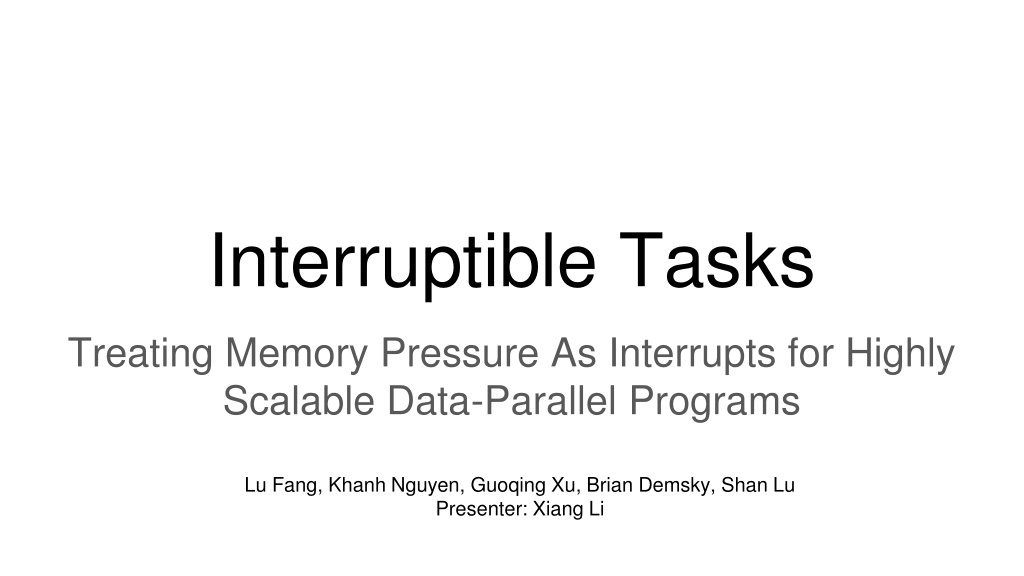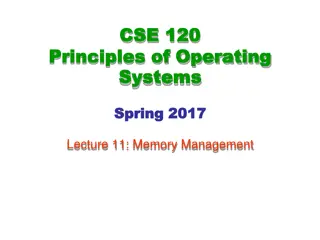Managing Memory Pressure in Data-Parallel Programs
Addressing memory pressure in data-parallel programs is crucial to prevent performance degradation and out-of-memory errors. The solution lies in Interruptible Tasks (ITasks), a new type of data-parallel tasks that can be interrupted and memory reclaimed to optimize system scalability. Current challenges include individual node memory pressure and practical solutions involve manual tuning and automated tools. Real-world memory issues like hot keys and large intermediate results further emphasize the need for effective memory management strategies.
Download Presentation

Please find below an Image/Link to download the presentation.
The content on the website is provided AS IS for your information and personal use only. It may not be sold, licensed, or shared on other websites without obtaining consent from the author. Download presentation by click this link. If you encounter any issues during the download, it is possible that the publisher has removed the file from their server.
E N D
Presentation Transcript
Interruptible Tasks Treating Memory Pressure As Interrupts for Highly Scalable Data-Parallel Programs Lu Fang, Khanh Nguyen, Guoqing Xu, Brian Demsky, Shan Lu Presenter: Xiang Li
Introduction Problem: Memory Pressure - huge garbage collection burden, out of memory errors Goal: a general, multi-platform solution Product: Interruptible Tasks (ITasks) - new type of data-parallel tasks that can be interrupted upon memory pressure with part or all of their used memory reclaimed and resumed when the pressure goes away
Individual Node Memory Pressure The execution pushes the heap limit soon after it starts and the systems struggles to find memory to allocate new objects throughout the execution. Memory problems lead to excessive GC effort and out-of-memory errors, significantly hurting system performance and scalability. No existing technique can systematically address the individual node memory pressure problem.
Practical Solutions: Manual Tuning Manual tuning of framework parameters. Example: reduce input size for each task and/or degree of parallelism. Difficult, impossible to find a general configuration when considering data skewness and different behaviors of the tasks.
Practical Solutions: Automated Tools Develop automated tuning tools: YARN, Mesos, Starfish: try to allocate resources by predicting a task s future resource usage based on its past utilization. However, the memory behaviors are difficult to predict: YARN schedules a task in StackOverflow to process a long post on a node, which incurs huge memory consumption where other tasks are already running, based on the observation that a normal task did not take much memory in the past. Out-of-core computations: framework-specific
Real World Memory Problems Hot Keys: some particular keys have large numbers of associated values Large Intermediate Results: intermediate data in large Java collections which have non-trivial space overhead, cached in the memory Recommend solutions in StackOverflow: Configuration Tuning: change framework parameters - labor intensive Skew Fixing: find all long sentences in the dataset and break into short sentences - impossible to be general
ITasks: Execution When the system detects memory pressure, a selected task is interrupted, with part or all of its consumed memory reclaimed. This process is repeated until the pressure disappears. Stay in memory and wait to be aggregated until all intermediate results for the same input are produced Lazily Serialized: serialize if needed Pushed to the next operator in the pipeline immediately Keep in memory and serialize it when needed Lazily Serialized Safe to discard when the corresponding thread is terminated
ITasks: Timing We want to interrupt a task when the overall memory pressure comes and when its execution arrives at a safe state. Two factors: per-process system memory availability - avoid unnecessary interrupts: uses long and useless GC as indicator per-thread/task data processing status - terminating by recording minimum local info of execution: understand data processing status
ITasks: Programming Model Adjustments to original code: 1.Implement the DataPartition interface: wrap around the framework s existing data representation (k-v buffer) 2.Make the original task s Java class inherit the ITask abstract class and implements its four abstract methods (initialize(), interrupt(), cleanup(), process()) 3.Glue code to specify the input-output relationships between data partitions and ITasks.
ITasks: Programming Model tag specifies how partial results should be aggregated, cursor marks the boundary between the processed and unprocessed parts of the input loads the input and creates local (auxiliary) data structures before starting data processing specifies the interrupt handling logic contains the finalization logic when the entire input is processed implements the main data processing logic scaleLoop iterates over the input data tuples and invokes the process method to process a tuple in each iteration. It checks memory availability at the beginning of each iteration, ensuring that interrupts can only occur at safe points (i.e., not in the middle of processing a tuple).
Dataflow Semantics An ITask will be invoked as long as: 1.There exists a DataPartition object in the partition queue 2.The cursor of the partition does not point to the end Example: - - ITaskB is now a successor of ITasksA Whenever a DataPartitionB is produced by ITaskA, it can be immediately processed by ITaskB
ITasks: Dataflow of an Execution Entire input is processed; finalize Determined by IRS Interrupted, pushed into partition queue The state machine of ITask execution
MITask: ITask with Multiple Inputs The use of tags each instance (thread) of an MITask is created to process a set of DataPartition objects that have the same tag multiple MITask instances can be launched in parallel to process different groups of data partitions with distinct tags a special iterator PartitionIterator is used to iterate over partitions: a lazy, out-of-core iterator that does not need all partitions to be simultaneously present in memory; a partition on disk is loaded only if it is about to be visited.
ITasks in Existing Frameworks Hyracks
ITasks in Existing Frameworks: Hyracks - Map thread: the output can be directly sent to shuffling - Reduce thread: the output needs to be tagged with the hash bucket ID for Merge task - Merge thread: the output needs to be tagged for Merge again
ITasks in Existing Frameworks: Hadoop Let Mapper and Reducer extend ITask, so that all user defined tasks automatically become ITasks. The run method in Mapper/Reduce invoke the ITask state machine; its original functionality is moved into the ScaleLoop method.
ITask Runtime System (IRS) Warm-up phase: Initially one thread is created, as the task executes the system gradually increases the number of threads until it reaches optimal execution point. Three components: 1. - - Monitor When to interrupt or reactivate an ITask IRS monitors the global memory usage and notifies the scheduler of the system s memory availability 2. Partition Manager - When to serialize or deserialize data partitions - Keeps track of each partition s latest serialization and deserialization timestamps to avoid thrashing. - Priority in of partitions in memory: Temporal Locality Rule and Finish Line Rule 3. Scheduler - Which ITask to interrupt or reactive - Selection of ITask to interrupt: MITask First Rule, Finish Line Rule, Speed Rule - Run ITask: Spatial Locality Rule, Finish Line Rule
Evaluation Hadoop performance comparisons
Evaluation Hyrack performance comparisons
Evaluation Hyrack performance comparisons
Conclusions - ITasks can be easily integrated into a distributed framework and interact seamlessly with the rest of the framework - The runtime is effective at reducing memory usage, thereby significantly improving the performance and scalability of a variety of data-parallel systems
References L. Fang, K. Nguyen, G. Xu, B. Demsky, and S. Lu. Interruptable tasks: Treating memory pressure as interrupts for highly scalable data-parallel programs. In SOSP, 2015.























